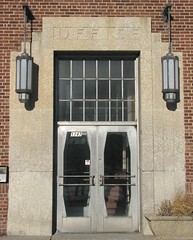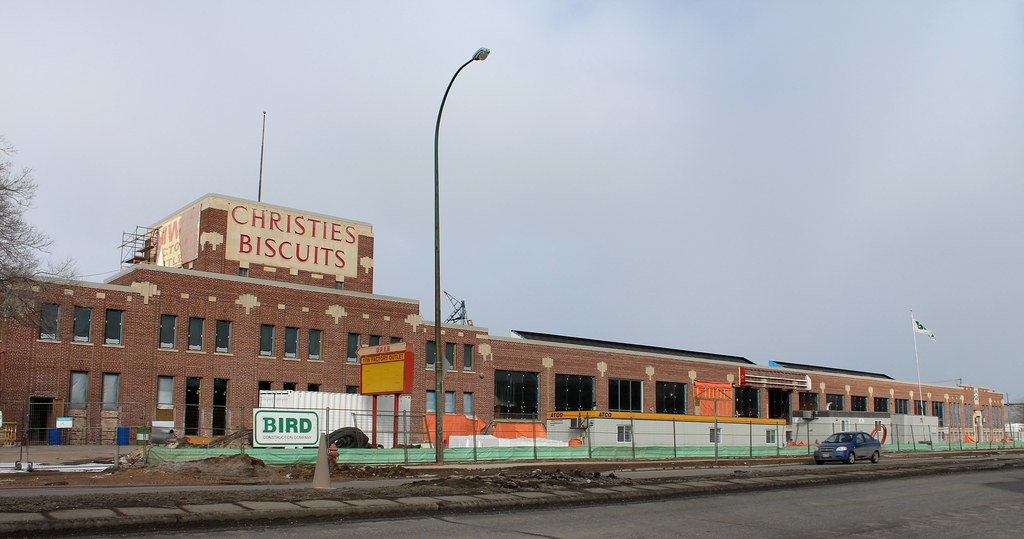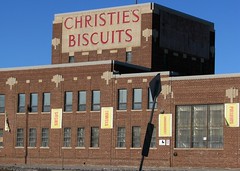I originally write about this building at West End Dumplings in 2012. Now that its transformation is almost complete, I thought I would shift it here !
Top: Winnipeg Free Press, February 16, 1932
Bottom: ca 2012
Place: Christie Brown BakeryAddress: 1147 Notre Dame Street
Opened: February 15, 1932
Architect: George G. Teeter (supervising architect)
Contractor: Hazleton and Walin
Cost: $525,000
Commercial baker Christie Brown & Co. was created in Toronto in 1868 with the merger of two existing bakeries. William Christie served as the firm's first president.
By 1880, advertisements for their biscuits, cakes and other goods began appearing in Winnipeg newspapers.
In the early 1890s the company established a Western Canadian sales office in Winnipeg. It was first run by Adam Weir from Toronto. By 1900 the firm Scott, Peters and Co. of Princess Street were their representatives.
Christie Brown actively participated in Winnipeg's industrial exhibitions and sponsored a number of local sports teams and leagues.
Christie Brown actively participated in Winnipeg's industrial exhibitions and sponsored a number of local sports teams and leagues.
In 1928, the company was sold to American interests but the head office remained in Toronto.
Top: October 13, 1930, Winnipeg Tribune
Bottom: October 14, 1930, Winnipeg Tribune
It was to much fanfare that the company announced in October 1930 that it would build a new western plant in Winnipeg.
The city was reeling from the Depression. Many local manufacturers had closed down or limited their production. A number of large-scale construction projects, such as James Richardson and Sons' new headquarters at Portage and Main, were put on hold.
The drawings for the plant were done at the company's head office, the local supervising architect was George G. Teeter, Lombard Building. In November 1930, Christie awarded the construction contract to local firm Hazelton and Walin, one of six companies that bid on the work.
A $525,000 building permit was taken out in April 1931, though when the cost of the train sheds and the British-made manufacturing equipment was added, the price tag exceeded $1 million, (over $15 million in today's dollars.)
The 462 foot x 126 foot building is constructed of steel and concrete, the only wood used was maple for the floors. The exterior is of red brick sourced in Alberta with Manitoba Tyndall stone detail.
It housed the company's entire Western operations, from sales and executive offices to warehousing and shipping. Vehicles, both truck and rail, delivered raw materials to the west end of the plant and the finished, packaged product was shipped from the delivery bays on the east end.
February 13, 1932, Winnipeg Tribune
The factory was a model of employee comforts.
Large windows on all four sides of the building plus skylights allowed for the maximum use of natural light and ventilation. An early form of air conditioning was used in warmer months to keep temperatures cool. Iced water ran to a series of water fountains throughout the factory.
There was a well appointed cafeteria and staff lounges that included a radio room and showers. Men had a smoking room while women had a 'rest and recreation' parlour.
The machinery, custom built mainly in England for the plant, featured the latest in technology with automated doors and conveyor belts. The ice cream cone room, for instance, could turn out 6,000 cones a day at capacity.
Winnipeg Free Press, February 16, 1932
Company executives, including plant manager Charles E. Potter, a long-time Christie employee from the east welcomed dignitaries at a luncheon on February 15, 1932. Later in the day the doors were thrown open to all Winnipeggers to come have a tour.
The factory produced a wide range of Christie products: Cookies, including Arrowroot biscuits, soda crackers, ice cream cones and cakes.
In 1954 the plant underwent a $2 million expansion that added 25 feet to the rear of the building.
"Mr Christie" made good cookies, and other baked goods, on Notre Dame Avenue until 1978 when the plant was closed.
The following year, Mid West Garments, (now MWG Apparel), a Winnipeg company whose roots date back to 1928, relocated here from their Rorie Street plant.
In August 2010, the Winnipeg Regional Health Authority announced that MWG Apparel would consolidate its space at the rear of the building to allow for the construction of a 95,000 square foot Specialized Services for Children and Youth (SSCY) Centre that will replace the old Rehabilitation Centre for Children (RCC) on Wellington Crescent.
The project's $22 million price tag is funded by a $17 million commitment from the provincial government and $5 million from community fundraising.
The SSCY Centre opened in Spring 2016.
Related:
My photo album of the Christie Biscuit plant
Christie's Biscuit Building gets repackaged Wpg Free Press (Jun 2016)
Former Christie's Factory to become support hub CBC (Jun 2016)
Work to start on rehab centre Wpg Free Press (2011)
Children's services get new home WRHA (2010)
March 19, 1909, Winnipeg Free Press
For more Winnipeg baking history, check out my posts about Canada Bread and Bryce's Bakery on Burnell Street and the Speirs-Parnell / Weston Bakery on Elgin.











No comments:
Post a Comment